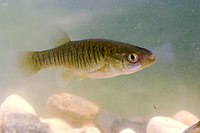Salt pannes and pools
This article needs additional citations for verification. (December 2015) |
Salt pannes and pools are water retaining depressions located within
Salt pannes and pools are unique
- Substrate type: affects the ability of the depression to hold water.
- Depth and diameter: affect water temperature and evaporation rate in the depression. A shallow and wide pool will evaporate at a greater rate than a pool of the same volume of water which is deeper and has a smaller surface area. Evaporation rate also affects salinity, the higher the evaporation rate the higher the salinity, with rates as high as a third greater than ocean water.
- Location within the intertidal zone, whether high marsh or low marsh and distance from the mean low tide mark which affects the length and duration of inundation until the depression is subject to evaporation as well as length of time until the rising tide replenishes the water volume.
These factors affect the types of species which can survive within the various types of salt pannes and pools.
Variants of salt pannes and pools:
Low salt marsh
- Low salt marsh panne
Usually devoid of vegetation, that may be present include smooth cordgrass (
High salt marsh
- Arrow-grass (forb) panne
Briefly flooded, very shallow with a moderate amount of vegetation usually dominated by arrow-grass (
- Smooth cord-grass (short form) panne
Shallow
Salt marsh mosquito panne

Minimal vegetation often found on the upper half of the high salt marsh. It is typically deeper than forb and smooth cord-grass pannes. Usually flooded by the higher of the two
Widgeon grass (
Brackish water marsh
Brackish marsh panne variants occur in brackish marshes (short graminoid variant), one of the native dominant species is spike grass (Distichlis spicata), some brackish marsh pannes are dominated by the narrow-leaved cattail (Typha angustifolia) an invasive exotic species.
- Mixed graminoid - forb panne
Shallow depressions flooded for only for a brief time and are characterized by a variable mix of
- Sparsely vegetated panne
Saturated, mud dominated pannes are occasionally found in the transition zone next to forested uplands where they are shaded by overhanging tree branches thus inhibiting evaporation. This is the preferred habitat for the uncommon seaside crowfoot (




